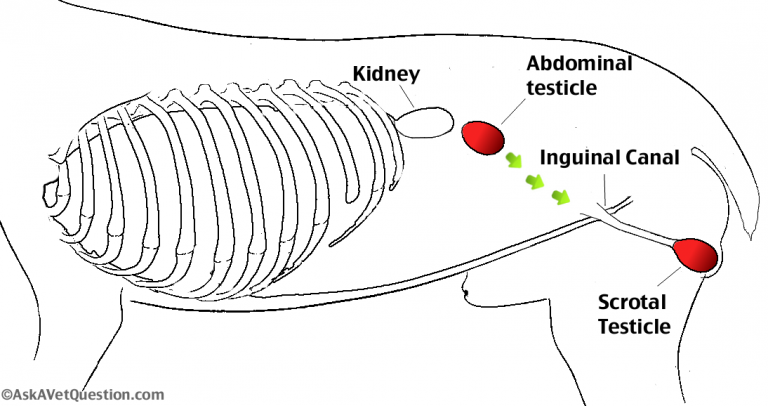
Cryptorchism
Apart from the obvious cosmetic implications (e.g. one testicle is not acceptable in the show ring), cryptorchidism also has implications on the health, behaviour, fertility and breeding value of the affected animal.
Cryptorchidism as the condition whereby one or both testicles are not present within the scrotal sac of the animal (dog or cat) by 8 weeks of age. Using this definition, animals whose testicles have not descended into the scrotum by this time should ideally not be bred from and should be considered cryptorchid.
Animals can be unilateral or bilateral cryptorchids. The production of testosterone (main testicular hormone) is not affected by temperature and, as a result, undescended testicles will still make plenty of this “male hormone” regardless of the fact that the undescended testicle itself is effectively infertile. So animals may be more aggressive than non cryptorchids until they will be neutered.
Cryptorchid testicles are prone to a number of significant and potentially life-threatening medical conditions that are not as commonly encountered in the correctly-descended testicle. These include:
testicular torsion, testicular cancer and various testicular-cancer-related conditions such as male feminizing syndrome, oestrogen toxicity (this causes severe pancytopenia: a complete deficiency in the numbers of red blood cells, white blood cells and platelets in the animal’s blood) and the hypersecretion of androgens such as testosterone.
“The risk of developing testicular neoplasia
is estimated to be at least ten times greater
in dogs with cryptorchidism than in normal dogs.”
Testicular torsion (twisted testicle condition):
Testicular torsion is the condition whereby the testis rotates on the end of its testicular cord (vas deferens and testicular blood supply), such that the vas deferens (also called the ductus deferens or spermatic cord) and testicular blood vessels become spiralled tightly around each other. This effectively results in the vas deferens strangling and cutting off the testicle’s blood supply. The testis itself becomes starved of blood and is subsequently unable to receive life-giving nutrients and oxygen nor eliminate metabolic waste products such as lactic acid and carbon dioxide. The ultimate consequence of this is that the strangled testis initially becomes very swollen and enlarged and painful and then it gradually begins to die and rot within the animal.
Testicular cancer (testicle cancer):
Canine testicles, even normally-positioned scrotal testicles, have a high chance of developing testicular cancer, with a risk that increases the longer the dog in question remains uncastrated. The prevention of canine testicular cancer is one of the many reasons why veterinarians promote the neutering of male, non-breeding, pet dogs. In the case of undescended testicles, particularly intra-abdominal testes, the risk of the undescended testicle or testicles developing cancerous changes is higher still and is themain reason why veterinarians advocate the surgical removal of undescended testes in the dog.
